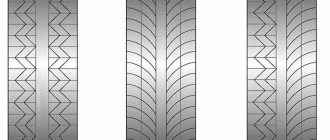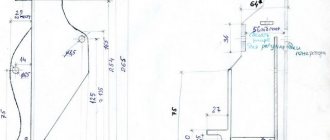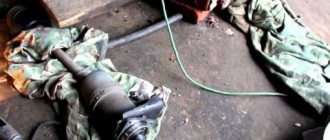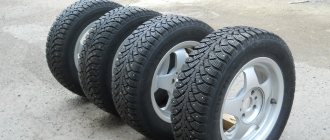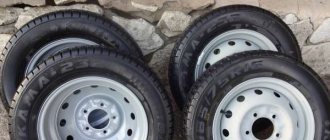Author: Evgeny Zhivoglyadov. Date of publication: July 18, 2016. Category: Automotive equipment.
Every car owner, sooner or later, is faced with the fact that there is not enough space in the car interior, and the standard trunk does not accommodate large cargo that may be needed in the country, fishing or on a hike. This problem can be solved by using a trailer that is attached to a towbar, but this method has significant disadvantages. Firstly, such pleasure is not cheap. Secondly, the trailer must be registered, and this, as you know, entails not only additional financial costs, but also the need to wait in queues. Thirdly, traveling with such a locomotive on your back is not the easiest or most enjoyable experience.
It is much easier, cheaper and more convenient to install roof rails on cars, the cost of which is from 1,000 rubles. But before moving on to recommendations for selection, let’s consider what exactly these car accessories are.
What are roof rails
Rails are a structure that consists of two metal arches attached to the roof of the car. With the help of this simple device, additional space appears for transporting large cargo.
Today there are two types of roof rails:
- Longitudinal (“rails”). Typically, such rails are installed on crossovers, SUVs, minivans and station wagons. Most often, longitudinal roof rails come as standard equipment on a car, but they can also be installed as a separate accessory. To do this, it is enough to find fastening points on the roof of the car, which are usually closed with plugs.
- Transverse (“sleepers”). Rails of this type are designed for any type of body. Car cross rails can be universal or specially designed for a specific car brand.
- Combined. Such structures include longitudinal rails and additional cross members. They have greater load capacity and reliability, but are slightly more expensive. The installation of such roof rails is as simple as that of conventional rails.
Healthy! Additional slats in combination models increase the overall weight of the structure, which increases fuel consumption by almost 15%. Therefore, it is better to install crossbars only when necessary.
Car owners prefer longitudinal models, as they have a streamlined shape and look harmonious with a car of any class. However, transverse fastenings also have a number of advantages. For example, they allow you to transport long loads.
Therefore, when choosing the type of this accessory, it is worth considering what you will transport by car. We will also consider the features of these fasteners.
Installing roof rails on a Chevrolet Niva. Step-by-step instruction.
Those who are faced with a lack of space in the standard trunk of a Chevrolet Niva when transporting large cargo have more than once thought about installing roof rails. They are metal arcs framed with decor. In addition to the fact that roof rails have a practical function, they also add a certain style to the car. Some models in top trim levels are equipped with a roof rack from the factory. Meanwhile, installing roof rails on a Chevrolet Niva is quite simple, since the manufacturer foresaw its possibility and prepared the mounting locations for the brackets.
Features and characteristics of roof rails
Before purchasing roof rails, it is worth considering that the weight of the transported cargo should not be more than 50 kg. To transport items of greater weight on an SUV like the Chevrolet Niva, it is better to install a power rack, which allows you to carry up to 300 kg on the roof of the car.
Rails are made of steel, aluminum or metal-plastic and coated on top with paint and varnish or decorative plastic composition.
If we talk about the advantages of roof rails compared to roof racks for the Chevrolet Niva and other cars, then it is worth highlighting the following advantages:
- They are easy to install and dismantle.
- Thanks to their streamlined shape, the roof rails do not affect the aerodynamics of the car.
- The weight of the slats is no more than 10 kg.
- The cost of roof rails is lower than that of bulky luggage compartments (regular longitudinal “rails” cost about 5,000-7,000 thousand rubles, and combined roof rails with transverse crossbars will cost about 8,000 rubles).
Despite the ease of installation and other advantages of these fasteners, even when choosing universal roof rails for a car, it is necessary to take into account some nuances.
Equipment
The set of roof rails includes 2 transverse and longitudinal roof rails. Thus, this ensures that the roof rails can be used as a full-fledged trunk.
The roof rails have passed many safety tests, are individually packaged, are certified and are accompanied by a technical passport.
The warranty on roof rails for the Chevy Niva becomes 1 year. The price of a set of roof rails with crossbars is approximately 7,200 rubles. The price of a set of roof rails without crossbars is RUB 5,600. Railing colours: silver, black.
Advantages of roof rails:
- Gives a complete look to the car;
- Installation is carried out in places specially provided by the manufacturer in the car body (NO BODY DRILLING REQUIRED);
- The kit includes all necessary fasteners;
- Load capacity 50 kg.
Increased fuel consumption (rails without weights):
- Urban cycle: approximately 1-3%;
- Mixed: approximately 2-4%;
- Highway: approximately 4-6%.
Technical specifications:
- The roof rails are made of high-strength steel with two types of coating:
- Black moire;
- Colorless oxidation.
- Load capacity: 50 kg.
- 7 kg.
- installed on special mounting locations provided by the manufacturer
- The complete set of roof rails on the Niva-Gevrol contains all the necessary fastening elements.
- The warranty period stated by the manufacturer is 5 years.
For these elements of the additional luggage compartment, you can also purchase Petroil Tuning transverse bars, supplied separately.
What to look for when choosing roof rails for a Chevrolet Niva
Car markets offer a wide range of car accessories from different manufacturers. To choose good and reliable roof rails for your car, follow the recommendations:
- Pay attention to the operating instructions included with the roof rails. Usually it indicates which brands of cars these elements are compatible with. The fact is that the racks are fixed differently on different cars, so if you don’t find your car in the list of car models, it’s better to refuse such a purchase.
- It is better to choose slats that are made of steel or aluminum; metal-plastic structures have a shorter service life and cannot withstand loads.
Healthy! To test the strength, try bending the rail slightly in your hand. Of course, it will not bend, but if the element is made of low-quality material, you will feel the rail “walking” in your hand.
- Be sure to check with the seller about the maximum weight that the roof rails can withstand and their resistance to climatic conditions.
- Pay attention to the rack manufacturer. Today, Thule roof rails from a Swedish company that produces high-quality luggage systems for cars are considered the best and most reliable. Also, “Petroil” slats from . These items are suitable for both older SUV models and the newest ones.
If you are in doubt about your choice, contact your car dealer and ask them about the most suitable roof rail models.
After purchasing transverse or longitudinal rails for the roof of a car, every car enthusiast is faced with the question of how to install them correctly.
Installing roof rails on a Chevrolet Niva
There are several manufacturers of roof rails for the Chevrolet Niva, including the official dealer. All types of luggage racks can be divided into two groups. The first ones are unoriginal. Their brackets are installed externally and screwed into factory-prepared holes. The second ones are original. The brackets are attached from the inside. You will have to drill holes in the roof.
Since not every owner wants to drill metal, and in addition it is necessary to leave the possibility of removing the roof rails, it is non-original devices that are popular. The kit has the following composition:
- Metal arcs;
- Fairings;
- Brackets;
- Protector made of anti-gravel film.
How to install roof rails on a car
At the factory, Chevrolet Niva models are not equipped with roof rails, but appropriate holes are made for them. There is nothing complicated in installing these elements, and the entire process is described in detail in the instructions supplied with the slats. However, before installation the following steps must be taken:
- Attach the purchased slats to the mounting points and check that the purchased accessories fit. If everything is fine, you can apply the markings.
- Installation must be performed on a clean vehicle. The contact points between plastic products and the roof of the car must be treated with primer 94 or other specialized lubricant.
- Monitor the ambient temperature. Rails can be installed at temperatures not lower than +12 degrees.
- After treating the surfaces, unscrew the fastenings of the products and fix them on the drains of the machine. It will take no more than 10 minutes, even for a person who has not previously engaged in such an installation.
After this, all you have to do is follow a few rules that will extend the life of the roof rails:
- The slats can be used no earlier than 1 day after installation.
- Do not “upgrade” metal fasteners.
- The door should not come into contact with the protective edging of the fairing.
- Try to distribute the load evenly.
- Install the cross bars as close to the power brackets as possible.
Installation.
When purchasing, you need to make sure that the parts are suitable for the specific vehicle. Because there are several basic types of fastenings that are incompatible with each other. After this you need to follow a few simple steps:
- Preparing the car It must be clean, the installation sites are additionally treated with silicone grease or primer 94
- Installation must be carried out in a warm box or outside at above-zero temperatures.
- We unscrew the fastenings on the roof rails and install them in the gutters of the car.
The influence of roof rails on car performance
Those wishing to decorate their car with a roof rack should be prepared for the fact that some technical characteristics will change.
Firstly, fuel consumption will increase. This happens due to the increase in the weight of the car, because the weight of the cargo transported on the roof can amount to tens of kilograms.
Secondly, controllability will deteriorate. Since the roof rails create additional resistance, the aerodynamic parameters change. Therefore, most prefer to install only longitudinal structures.
Two installation methods.
Installation of arches is done in two ways:
The longitudinal version is used more often, since this shape is more streamlined. The car encounters less air resistance, and, therefore, fuel consumption is practically not reduced. But transverse installation also has its advantages - thanks to this arrangement, it is possible to transport long loads without additional equipment.
Previously, for attaching the trunk to a car, there were special lugs located on top of the doors. Chevrolet Niva is one of the modern vehicles where the roof rail mounts are hidden. They are located under a special plug in the drainage area. But despite the fact that the fastening is carried out directly to the body. Still, many people have a question about what is the maximum load possible on the roof rails. The permissible load on the arches is 50 kilograms. If it is necessary to transport heavier loads, then it is necessary to use special fastenings that allow you to transport up to 300 kilograms. It should be understood that these parameters are small. Due to the fact that the overloaded upper part of the car impairs handling. Excessive resistance to air flow is created, reducing speed and increasing fuel consumption. It also creates a risk of the vehicle tipping over when turning. Therefore, it is recommended to transport small items such as bicycles, tents, and small furniture. And at the same time maintain a reasonable speed limit. You can also additionally equip the roof rails with additional jumpers to install a roof rack on the roof of a Niva Chevrolet car.
Chevrolet Niva dimensions, dimensions, volumes, Chevrolet NIVA 4x4 ground clearance, trunk
The dimensions of the Chevrolet Niva classify this 5-door crossover as a very compact car. In fact, the length of the Chevrolet NIVA does not exceed 4 meters.
However, such compact dimensions, combined with high ground clearance, which is more than 20 centimeters, and small overhangs, make the small crossover ready for any off-road obstacles. In the photo at the beginning of the article you can see all the main linear dimensions of the Chevy Niva . I would like to immediately note that the official dimensions given by the manufacturer and actual measurements may give different results.
Installation instructions:
- Before installation, be sure to try the kit on the car and adjust all the parts; preliminary markings will allow you to more accurately take into account the geometry of the outer surface of the car;
- Installation should only be carried out on a clean vehicle. It is recommended to treat the places of contact of plastic parts with the roof of the car with primer 94 produced by 3M, according to the instructions for use;
- Installation should be carried out at a temperature not lower than +12°C on a clean, pre-degreased surface. It is recommended that two people perform all installation operations.
Tread sticker
The protector will protect the paintwork under the fairing, so it is tedious to glue it in the place where the roof rail will support. To do this, the rack is pre-attached to the roof.
The holes for the brackets are located under the door seals.
Once the rack is installed, you need to mark where the fairing will support. Some kits come with special markers. If they are not there, then masking tape will do, which is glued around the perimeter of the support. The protector is glued to the designated place.




